Is After Effects running slow on your Windows computer? Adobe After Effects is a commercial VFX, motion graphics, and compositing software that helps you create professional videos. It is used in several fields, including movie-making, video games, etc. As reported by some users, the After Effects app keeps lagging on their PC. The tasks like editing, rendering, etc., are done too slowly, frustrating users.
After Effects is a CPU-intensive application and can run smoothly only with high-end hardware (graphics card, multiple-core CPU, etc.), however, users with good computers are also facing the same issue.
Why is my Adobe After Effects so slow?
Several factors may affect the performance of After Effects and make it run slow. One of the primary reasons is that your PC doesn’t meet the minimum system requirements of the software. After Effects requires a high-end PC with greater RAM to run smoothly. Besides that, outdated graphics drivers can also slow down the app. Media cache stored by After Effects is another reason for the same issue. GPU acceleration , using an outdated app version, and too many background programs running on your computer are other reasons affecting After Effects’ performance.
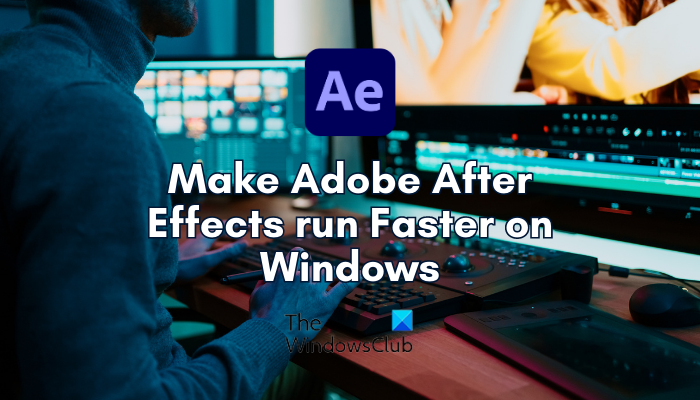
Adobe After Effects running slow
If the Adobe After Effects app is running slow on your Windows computer, you can use the below methods to make it run faster and smoother:
- Make sure your OS, After Effects and graphics driver are up-to-date.
- Disable the Hardware Accelerate feature in After Effects.
- Delete the After Effects Media cache.
- Modify Adaptive Resolution.
- Increase RAM.
- Increase the rendering speed.
- Disable Ray Tracing.
- Use the Enable Multi-Frame Rendering option.
- Some more tips to run After Effects faster.
- Consider upgrading your hardware.
1] Make sure your OS,After Effects and graphics driver are up-to-date
First of all, you need to make sure that you are not facing this issue because of a problem at your system’s end. If you are using an outdated version of your Windows OS or your graphics driver, you are likely to experience slow performance issues with After Effects. Hence, if the scenario is applicable, update After Effects, install pending Windows updates and update your graphics driver. After that, you will notice an improvement in the performance of After Effects.
2] Disable the Hardware Accelerate feature in After Effects
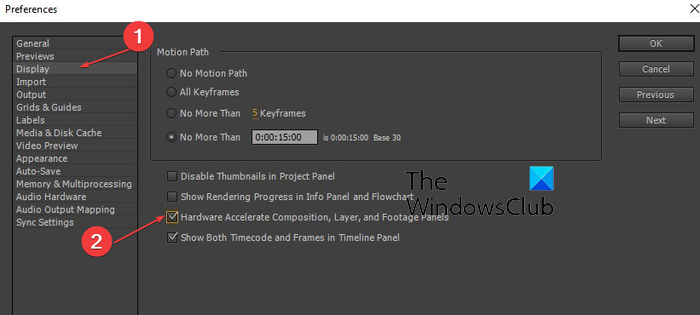
If you have enabled GPU acceleration in After Effects, disable it and then check if the problem is resolved. The Hardware Accelerate or GPU acceleration feature is a handy function that enables you to speed up graphics processing in After Effects. However, this function can also cause stability and other performance issues on some PCs.
So, if the scenario is applicable, turn off hardware acceleration in After Effects and see if the problem is resolved. Here are the steps to do that:
- First, open After Effects and go to the After Effects menu option from the top.
- Now, click on the Preferences option and then move to the Display tab.
- After that, deselect the checkbox associated with the Hardware Accelerate Composition, Layer, and Footage Panels option and tap on the OK button.
- Once done, restart After Effects and then check if it is running better now.
On the other hand, if you are using a high-end computer and want to fasten the processing speed of After Effects, you can enable the hardware acceleration feature.
Read: Fix Adobe Premiere Pro high CPU usage.
3] Delete the After Effects Media cache
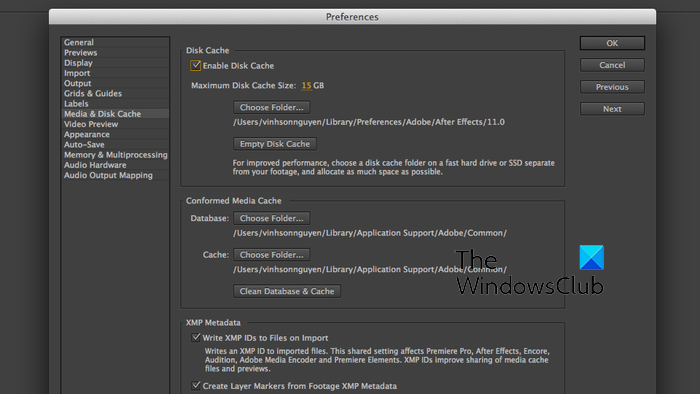
Another method you can try to run After Effects is to clean up the media cache files. After Effects creates cache files that help in quick previews of rendered clips and other tasks. However, if the cache is clogged up on your computer, it will make After Effects run slow and lag. Hence, you must clear the media cache and then see if the problem is fixed. Here’s how:
- First, open After Effects and click on the After Effects menu > Preferences option.
- Now, move to the Media and Disk Cache tab from the left-side pane.
- Next, click on the Empty Disk Cache button and press OK.
- After that, press the Clean Database & Cache button and then tap on OK.
- Once done, relaunch After Effects and see if there is an improvement in its performance.
Read: Disable Visual Effects to optimize performance in Windows.
4] Modify Adaptive Resolution
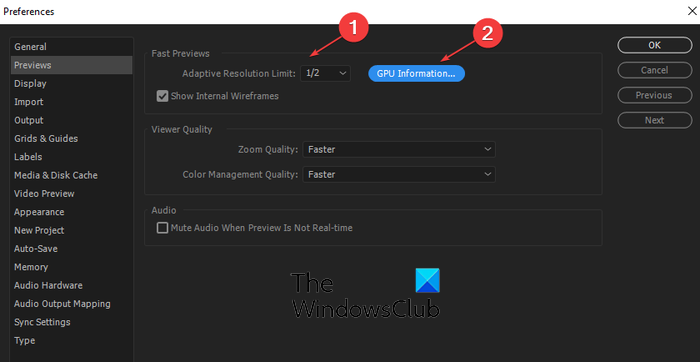
Adaptive Resolution in After Effects basically determines how much information should be displayed from a high-resolution video clip. You can try adjusting the value of Adaptive Resolution and see what works well for you. Here are the steps to do that:
- First, open After Effects and click on the After Effects > Preferences option.
- Now, move to the Previews tab.
- Next, click on the Adaptive Resolution Limit drop-down button and select 1/16.
- After that, press the GPU Information button and set Texture Memory to 1152.
- Finally, press the OK button to save changes and see if the issue is fixed.
5] Increase RAM
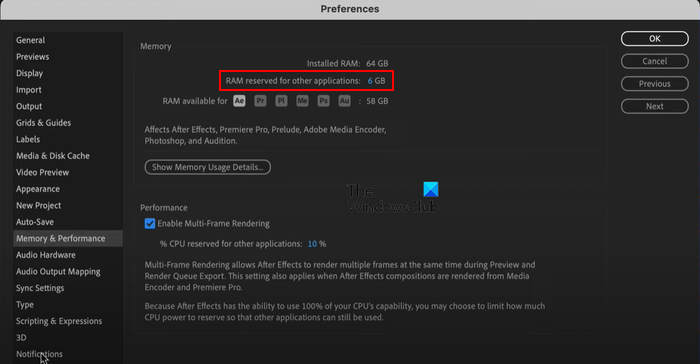
Another tip to make After Effects run faster is to increase RAM. If your system running out of memory, you can assign more RAM to After Effects to improve its speed and performance. For that, we will be decreasing the RAM used by other applications. Here’s how:
- First, open the app and click on the After Effects menu > Preferences option.
- In the Preferences window, go to the Memory & Performance tab. Here, you will see the total installed memory.
- Now, change the value of the RAM reserved for other applications option to a lower value than the current one, like 2.
This will automatically increase the RAM assigned to After Effects. After doing so, you will see an improvement in the speed of the program.
See: Adobe Media encoder not installed in Premiere Pro.
6] Increase the rendering speed
You can also increase the clip rendering speed of After Effects using the Secret menu. Here’s how:
First, hold the Shift key on your keyboard and then click on the After Effects > Preferences option. You will now see a Secret tab in the left-side pane. From here, tick the checkboxes called Disable Layer Cache and Ignore Sequence Rendering Errors. And then, set the Purge Every value to a lower value. Once done, you will see that the rendering speed is now enhanced.
7] Disable Ray Tracing
Ray-Traced 3D is a handy function in After Effects that renders stunning images and animations by simulating rays of light. However, this function can stress your CPU causing After Effects to lag. So, you can try disabling it for your composition and see if the issue is resolved.
To disable the Ray-Traced 3D renderer, open the Composition Settings panel. Now, move to the Advanced tab and change the “Renderer” option to the Classic 3D renderer instead of Ray-Traced 3D. See if there is an improvement in After Effects’ performance.
Read: Premiere Pro crashing or stops working on Windows.
8] Use the Enable Multi-Frame Rendering option
Enable Multi-Frame Rendering is a handy function offered by After Effects that enables it to render more frames at the same time. You can turn on this feature if your CPU has more than 4 cores and then see if the problem is resolved.
Follow the below steps to do that (refer to screenshot in method (5)):
- First, open After Effects and go to the After Effects menu > Preferences.
- Now, move to the Memory & Performance tab.
- After that, tick the Enable Multi-Frame Rendering checkbox and press the OK button.
Read: How to save or export Premiere Pro projects to MP4?
9] Some more tips to run After Effects faster
There are some more tips to run After Effects faster or make it render movies faster. Here are those tips and tricks:
Make sure After Effects is up-to-date. To check for available updates, open the program and click on the Help > Updates option. Install the pending updates and restart After Effects to check if the problem is resolved.
If there are multiple programs running on your computer that are not needed at the moment, you can close them. Open Task Manager using Ctrl+Shift+Esc and terminate all apps except for After Effects using the End task button.
You can also enable the Composition > Preview > Cache Frames When Idle option and see if there is an improvement in rendering speed.
If you are working on a big composition or project, it will make After Effects laggy. So, you can split the composition into multiple smaller parts and then see if the issue is resolved. Or, you can also remove or trim unused layers in a composition and check whether it helps.
Another thing you can do is disable Motion Blur, Depth of Field, and other effects if not needed in your composition.
If possible, you can run After Effects from a Solid State Drive. It has a better read and write speed than a HDD.
You can try closing the Composition Preview window and see if the rendering process becomes faster.
You can also skip keyframes to speed up After Effects. It will affect the video preview but speed up the loading process. You can go to the Preview menu, and under the Skip drop-down menu, choose a higher value. See if this helps.
See: How to stabilize Shaky Video Footage in Adobe Premiere Pro?
10] Consider upgrading your hardware
In case none of the above solutions worked for you, consider upgrading your hardware. After Effects is a CPU and GPU-intensive program that required high-end computer resources. Its system requirements are described below:
- Processor: Intel or AMD Quad-Core Processor, 8-Core or above for Multi-Frame Rendering recommended.
- RAM: 16 GB RAM, 32 GB recommended.
- GPU: 2 GB GPU VRAM, 4GB or more GPU VRAM recommended.
- Hard disk space: 15GB of available hard-disk space.
- Monitor resolution:1920 x 1080 or greater.
You can upgrade your hardware based on the above system requirements of After Effects.
I hope this helps!
Is 8GB RAM enough for After Effects?
As mentioned on the official Adobe website, the minimum RAM required to run and use After Effects on a Windows PC is 16 GB. So, 8GB RAM is not enough to run After Effects smoothly. If you want to achieve the best performance from After Effects, 16GB memory or more is required.
Now read: Adobe After Effects high CPU and RAM usage.
Leave a Reply